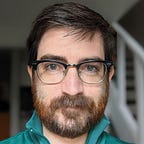“A Quiet Place” and the Limits of Utilitarian Screenwriting
In the follow-up to his 2018 breakout feature, John Krasinski replays the hits so rigorously that he winds up playing the misses as well. Both A Quiet Place and its creatively named sequel play by a strict set of rules, so they share appeal and drawbacks alike. I understood in advance I was likely to dislike the precise things I disliked about Part II as I did when it was a standalone project, but I was curious to see how the sequel might broaden or develop the core idea or what strange new places it might take the characters to. Without devolving into a tepid review of a tepid 2021 release, suffice it to say the second film’s relation to the first, particularly its adherence to the writing style, is deeply detrimental to a movie that erstwhile demonstrates Krasinski’s developing promise as a director.
In A Quiet Place — pick your favorite part — the main deal is you have to obey the title. Make noise and die, pipe down and live. That’s the basics, and the basics are everything. Cause and effect. Around the suburban Pennsylvania town, where our barefoot Ma and Pa live with their deeply unfortunate children, prowl vicious Demogorgon-like monsters who suffer from acute hyperacusis. Much like the T-Rex in Jurassic Park who only eats children who can’t sit still, these suckers eat anybody who causes too much of a racket. Therefore in order to live, Platinum Dunes’ first family has to traverse their post-apocalypse in silence. This concept and the hushed, largely dialogue-free execution is a huge part of the draw. Particularly in theater sound, the setup goes a long way to add a layer of tension to mundane moments. If a nail runs through a foot, the moment isn’t just about experiencing a character’s physical pain, but the inherent hardship of shutting up when there’s, you know, a nail in your foot. The premise is one which rewards a simplistic approach, and in general the atmosphere, the drama and the scares can all revolve around mundane items under the pressure not to make a sound.
Where both movies badly lose their way is in balancing the family drama and the horror action. There are multiple causes of this in my opinion, but Krasinski’s mechanical writing is an underlying layer shared by both halves of the movie. Every banal object in A Quiet Place functions as a Chekov’s first act gun. Through both movies, particularly when taken as a pair, there is a totally overwhelming level of setup and payoff, of moments homaged. Whether it’s a nail, a toy rocket, or a hearing aid, the script hinges on each tiny object running the length of the story. Every conflict and solution is foreshadowed, and every writing choice feels glaringly obvious. It’s how you end up with the inadvertent hilarity of the “What is the WEAKNESS” white board, a dopey exposition tool that also grants the movie’s obvious solution in, you guessed it, the first act.
The idea of these choices is to give the action and drama a realistic sense of consequence, but all it really amounts to is audience payoff. If done properly, we’d be convinced the family survive by their ability to account for even the smallest minutiae, because the distance between life and death is so razor thin in this world. The issue with that approach are the awkward questions that arise about the story’s conflict. To make the narrative work, Ma has to be barefoot to step on that nail. Ma and Pa have to have a baby to create incident for the story to happen, but that decision making is completely at odds with the dogged, detailed utilitarian writing. They tell you Ma is savvy enough to know shoes will make too much noise, but she and Pa are stupid enough to have a baby. The nature of the conflict doesn’t fit within the self-imposed logical constraints, and as a result is over-enunciated writing.
All writing, just as all filmmaking is designed to give an impression. It’s an illusory art, and that’s why picking at plot holes largely misses the point. Every story has to find a way to convince the audience the conflict is a result of character flaws in such a way as to make the organic and the mechanical mesh. In a way the easiest solution for both A Quiet Place films is to lean more heavily into ambiguity. Include a few moments where a very loud sound doesn’t attract a monster. Cast doubt such that the rules themselves are in doubt, and let that inform the dramatic moments of the film. It would make things less repetitive and predictable. Character motivations could certainly be a bit more relaxed, less scrutinized. You still end up with questions of why no one ever ransacked that pharmacy in the four years between Ma visits, but we can’t solve every problem all at once. A Quiet Place Part III might start by emphasizing the set-piece over the severe drama. At least there, Krasinski’s cause and effect approach can be exciting instead of inuring.
